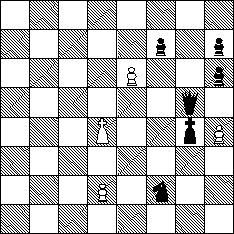Check out McCooey's Hexagonal Chess, our featured variant for May, 2025.
Check out McCooey's Hexagonal Chess, our featured variant for May, 2025.
Stefanos Pantazis, editor of The US Problem Bulletin, has sent me two problems that appeared in that journal and did win a prize there.
This is the first problem: You can also look at the second problem: a helpstalemate in 4 moves.
This problem was composed by George P. Sphicas, was published in The US Problem Bulletin in 1993, and won a Second Prize.
 White:
White:
King d4; Pawn d2, e6, h4.
Black:
King g4; Queen g5; Knight f2; Pawn f7, h6, h7.
Circe. Series-selfmate in 17 moves.
(b) Move the black knight from f2 to h5, and solve the problem again.
Circe is, as Stefanos Pantazis wrote me, probably the most popular fairy condition among problemists; Circe Chess is also occasionally played as a game between two players, but not too often. In Circe a unit that is captured is immediately reborn on its array square: the square where it stood on the opening setup. A rook, bishop, or knight is reborn on a square of the same colour as the square on which it was captured; a pawn on a square (in the 2nd or 7th rank) in the same file on which it was taken. When the square is occupied, the piece disappears.
A Series-selfmate in 17 moves means that white first makes 17 consecutive moves (black does not move in between these moves), such that black then is forced to mate white in one turn: all legal moves of black on the position after the 17 moves of white will mate white in one. Note that white can give check only with his last move of the series.
The problem consists actually of two parts: the problem as stated, and the problem where the black knight from f2 is put on h5. For this second position, the same condition again holds: give 17 consecutive moves for white such that then black must mate white in one move.